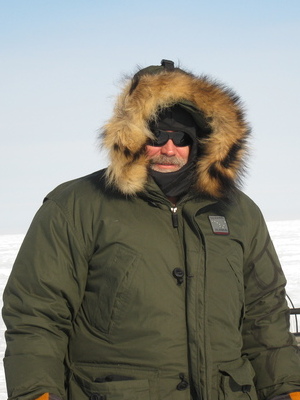
Frederick E. Nelson
Education
PhD, Geography (Geomorphology and Analytic Cartography), University of Michigan, 1982
MS, Geography (Geomorphology), Michigan State University, 1979
BS, (honors) Geography (Physical Geography), Northern Michigan University, 1973
Office Hours
By appointment
Research Interests
Fritz Nelson has long-standing interests in permafrost (perennially frozen ground) and periglacial (cold-climate, nonglacial) geomorphology. He has participated in research projects in many of the world’s cold regions and served on the faculties of Rutgers University, Cornell University, SUNY-Albany, the University of Delaware, Michigan State University, Northern Michigan University, and the University of Michigan. He has published ten monographs and edited volumes and more than 160 peer-reviewed scientific papers. He was Lead or Contributing Author on several of the Intergovernmental Panel on Climate Change Assessment Reports, and was part of the IPCC group collectively awarded the 2007 Nobel Peace Prize. Since 1991 he has played a leading role in the Circumpolar Active Layer Monitoring (CALM) program, which maintains a network of more than 200 permafrost observatories in the polar regions. He has served on the boards of the Arctic Institute of North America, the American Geographical Society, the U.S. Permafrost Association, the International Permafrost Association, and several international scientific journals.
In recent years Nelson has become increasingly involved in research on the history of Arctic science, polar exploration, and geographical science. He served for nearly a decade as Chair of the Association of American Geographers’ Archives and Association History Committee. At UW-Milwaukee he is closely involved in the extraordinary collections of the American Geographical Society Library. Nelson is eager to work with graduate students through the UWM Department of Geography’s degree programs, and on historical topics through the joint MA/MLS program administered by the department and the School of Library and Information Science.
Representative Publications
French, H. M. and Nelson, F.E. (eds., 2008). Frozen in Time: Permafrost and Engineering Problems (A Book by Siemon W. Muller). New York: American Society of Civil Engineers Technical Committee on Cold Regions Engineering, 280 + xxxvix pp.
Yang, M., Nelson, F.E., Shiklomanov, N.I., Yao, T., and Guo D. (2010). Climate change and permafrost on the Tibetan Plateau: A review of recent research. Earth-Science Reviews 103: 31-44.
Nelson, F.E. (2011). America’s Glory Road…on ice: Permafrost and the development of the Alcan Highway, 1942-1943. In: Brunn, S.B., Engineering Earth. Amsterdam: Kluwer, 643-661.
Nelson, F.E. and Shiklomanov, N.I. (2011). The Circumpolar Active Layer Monitoring Network—CALM III (2009-2014): Long-term Observations on the Climate-Active Layer-Permafrost System. pp. 9-21 in: Ambientes Periglaciares, Permafrost y Variabilidad Climática: II Congreso Ibérico de la International Permafrost Association. Alcalá, Spain: Universidad de Alcalá Servicio de Publicaciones.
Hinkel, K.M., and Nelson, F.E. (2012). Spatial and temporal aspects of the lake effect on the southern shore of Lake Superior. Theoretical and Applied Climatology 109(3): 415-428.
Nelson, F.E. (2013). ‘The advancement of exploration along scientific lines’: The American Geographical Society and the Arctic, 1851-1950. In: S.A. Kaplan and R.M. Peck (eds.), North by Degree: New Perspectives on Arctic Exploration. Philadelphia: American Philosophical Society, Lightning Rod Publications, 63-107.
Brigham, L.W. and Nelson, F.E. (eds., 2017). Geographical Perspectives on the Arctic. Special issue of Geographical Review 107(1): 1-257.
Fagan, J.E. and Nelson, F.E. (2017). Sampling designs in the Circumpolar Active Layer Monitoring (CALM) program. Permafrost and Periglacial Processes 28(1): 42-51.
Nelson, F.E. and Nyland, K.E. (2017). Periglacial cirque analogs: regional trends of cryoplanation terrace elevation in eastern Beringia. Geomorphology 293: 305-317.
Nyland, K.E., Klene, A.E., Brown, J., Shiklomanov, N.I., Nelson,F.E., Streletskiy, D.E., and Yoshikawa, K. (2017). Traditional Iñupiat ice cellars (Siġ-uaq) in Barrow, Alaska: characteristics, temperature monitoring, and distribution. Geographical Review 107(1): 143-158.
Streletsky, D.A., Shiklomanov, N.I., Little, J.D., Nelson, F.E., Brown, J., Nyland, K.E., and Klene, A.E. (2017). Thaw subsidence in undisturbed tundra landscapes, Barrow, Alaska, 1962-2015. Permafrost and Periglacial Processes 28(3): 566-572.
Hjort, J., Karjalainen, O., Aalto, J., Westerman, S., Romanovsky, V.E., Nelson, F.E., Etzelműller, B., and Luoto, M. (2018). Degrading permafrost puts Arctic infrastructure at risk by mid-century. Nature Communications 8: doi: 10.1038/s41467-018-07557-4
Klene, A.E. and Nelson, F.E. (2019). Urban geocryology: mapping urban-rural contrasts in active-layer thickness in the Barrow Peninsula, northern Alaska. Annals of the American Association of Geographers 109(5):1394-1414.
Queen, C.W., Nelson, F.E., Gunn, G., and Nyland, K.E. (2021). A characteristic periglacial.landform: Automated recognition and delineation of cryoplanation terraces in eastern Beringia. Permafrost and Periglacial Processes. 32(1): 35-46.doi:10.1002/ppp.2083
Nelson, F.E. and French, H.M. (2021). Stephen Taber and the development of North American cryostratigraphy and periglacial geomorphology. Permafrost and Periglacial Processes. 32(2) 213-230. doi: 10.1002/ppp.2096